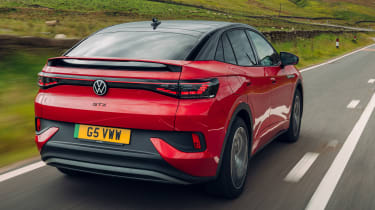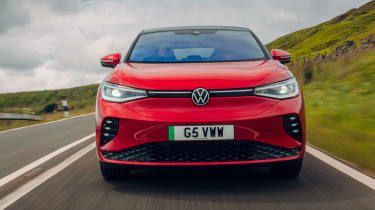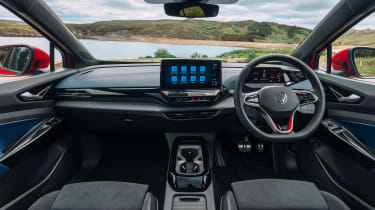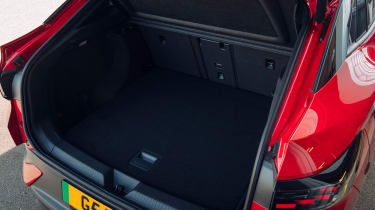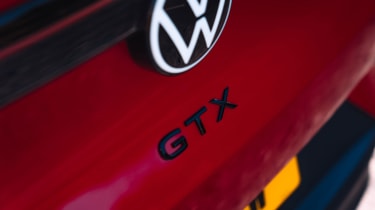Volkswagen ID.5 GTX review
The Volkswagen ID.5 GTX is fast and flashy, but it lacks the finesse of rivals and feels more like a posh trim level than a performance variant
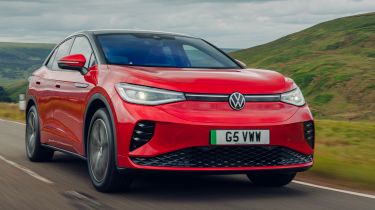
Pros
- Handles well
- Coupe styling
- No loss in practicality
Cons
- Expensive
- Rivals can charge faster
- Same flaws as ID.3 and ID.4
|
Car type |
Range |
Wallbox charge time |
Rapid charge |
|
Electric |
314 miles |
12hrs 15 mins (0-100%, 7.4kW) |
30mins (10-80%, 135kW) |
Volkswagen ID.5 GTX verdict
The Volkswagen ID.5 GTX is a bit ‘all talk and no trousers’; VW pitches the coupe crossover as a sporty SUV designed for burning up your local B-road, while not sacrificing much in the way of practicality. However, while the ID.5 GTX is deceptively spacious for something with a sloping roofline, it offers little more than point-and-squirt performance. It’s certainly fast in a straight line, but the equivalent Tesla is even quicker, and when it comes to the corners, the hot ID.5 offers very little advantage over the standard car, which wasn’t exactly a Lotus Eletre to drive in the first place. Expensive and unnecessary, we’d skip the Volkswagen ID.5 GTX and opt for one of the lesser ID.5 variants as these offer all the power most buyers will ever need.
Details, specs and alternatives
The ‘GTI’ nameplate is as tightly woven into the history of Volkswagen as cars named after insects, hippie culture and emissions scandals. But, with the arrival of the electric age, VW has created the new ‘GTX’ moniker for its high-performance electric cars, and this is the latest one: the Volkswagen ID.5 GTX.
A sleeker version of the Volkswagen ID.4 GTX and touted as a high-performance electric SUV, the ID.5 GTX will naturally be compared to the likes of the Kia EV6 GT, Ford Mustang Mach-E GT and Tesla Model Y Performance.
It’s significantly less powerful than those cars, though; the ID.5 GTX, alongside its Skoda Enyaq Coupe vRS sister car, gets two electric motors – one on each axle – and produces ‘only’ 295bhp and 460Nm of torque. Nevertheless, Volkswagen says this is enough for a 0-62mph time of just over six seconds and a top speed of 112mph.
Every Volkswagen ID.5 GTX gets the same 77kWh battery as the standard ID.5 Pro Performance models which, according to VW, provides a range of up to 314 miles on a single charge. There’s only one trim level to choose from too, dubbed ‘Style’. As you’d hope from a range-topping model, the ID.5 GTX Style comes loaded with standard equipment including 20-inch alloy wheels, LED lights front and rear, a 12-inch infotainment system with built-in sat nav, plus Apple CarPlay and Android Auto, a wireless smartphone charger, three-zone climate control, heated front sport seats, a panoramic glass roof and a reversing camera.
Range, battery size & charging
|
Range |
Wallbox charge time |
Rapid charge |
|
314 miles |
12hrs 15 mins (0-100%, 7.4kW) |
30mins (10-80%, 135kW) |
A range of up to 314 miles means the Volkswagen ID.5 GTX should theoretically be able to cover long distances – that is, if you resist making use of the extra power that’s on offer. This figure is competitive with other sporty electric SUVs such as the 319-mile Tesla Model Y Performance and the Mustang Mach-E GT, which is capable of up to 304 miles on a single charge. The Mach-E Extended Range, however, which is more comparable to the VW in terms of power, can go much further before needing to be plugged-in, with a maximum of 374 miles.
During our time with the ID.5 GTX, we averaged roughly 3.4 miles per kWh, which resulted in a range of around 262 miles – quite a bit less than Volkswagen’s claimed figure. Even worse, when we tested the car in winter, we were shown a figure of 2.7 miles per kWh, which means range was slashed to just 208 miles – more than 100 miles under the official number.
Thankfully, the ID.5 GTX is able to charge reasonably quickly, if not quite as fast as rivals. With a maximum DC speed of 135kW, you can rapid charge the car from 10-80% in around half an hour at a compatible public chargepoint. In comparison, a Hyundai Ioniq 5 or Kia EV6 can both charge at speeds of up to 233kW, which means if you find a 350kW charger, the same top up can take as little as 18 minutes.
Running costs & insurance
Starting from over £50,000, the ID.5 GTX is not only one of the most expensive Volkswagens on sale, but it also feels pretty pricey for something that has such a cheap-feeling interior – more on that later. Thankfully, the ID.5 GTX should be relatively cheap to run otherwise – especially for company-car drivers who can make use of the current 2% Benefit-in-Kind tax rate on EVs. Electric-car drivers are also blessed with zero road tax (VED) until 2025, and can enter London’s Congestion Charge and Ultra-Low Emissions (ULEZ) zones for free.
Despite its high-performance billing, the ID.5 GTX should be somewhat reasonable to insure; it sits in group 38, while even base versions of the Tesla Model Y start in group 46, rising to the top group 50 for Performance cars.
Performance, motor & drive
|
0-62mph |
Top speed |
Driven wheels |
Power |
|
6.3s |
112mph |
Four |
295bhp |
Volkswagen pitches the ID.5 GTX as a performance SUV; however, if you’ve spent any time in a full-blooded electric performance SUV like the Lotus Eletre, the Jaguar I-Pace or even any version of the Ford Mustang Mach-E, you’ll be left disappointed by the level of engagement the VW can offer.
First, we should preface this with the undeniable fact that while other performance electric SUVs are much faster than the ID.5 GTX on paper, the VW nonetheless offers more than plenty of performance for use on the road. As with most electric cars, the power delivery from the dual-motor setup is instant, pressing the driver and passengers back in their seats in a satisfying manner.
However, the Volkswagen ID.5 GTX only remains a performance SUV on the surface level as while it's certainly fast and benefits from upgraded brakes and suspension over the standard car, it doesn’t feel all that different in practice. The ride is on the firm side and it’s easy to sense the ID.5’s two-tonne weight in the corners. We like how the different drive modes add and remove weight from the steering, but it still lacks any kind of feel and tends to recentre itself in a disconcertingly spring-like fashion.
Interior, dashboard & infotainment
The Volkswagen ID.5 GTX’s cabin mirrors that of the smaller ID.3 hatchback and inherits all of that car’s draws and flaws. The overall design of the cabin is light and minimalist, plus the GTX model gets its own sporty touches including stitched Alcantara sports seats and red pinstripe accents. Material quality is less good, though, with plenty of hard and scratchy plastics scattered around the place which aren’t really befitting of a vehicle at this price point.
As per usual, everything in the ID.5 GTX’s cabin centres around the main touchscreen; this 12-inch display is pretty responsive, although VW’s operating system is laden with bugs that make it frustrating to use – we recommend using Apple CarPlay or Android Auto to help avoid this. Another annoyance are the climate controls, which are operated via fiddly touch-sensitive sliders that don’t illuminate in the dark, making them a pain to use at night.
Boot space, seating & practicality
|
Length |
Width |
Height |
Boot space (seats up/down) |
|
4,599mm |
1,852mm |
1,615mm |
549/1,561 litres |
You might expect the Volkswagen ID.5 GTX to be compromised due to its sleek coupe shape, yet it’s more practical than you might expect. Headroom, despite the sloping roofline and panoramic roof, is adequate even for adults, and the ID.5’s flat floor means that three people can easily sit abreast in the rear for short journeys.
Open the bootlid – in typical VW fashion, you have to pay extra to make it powered, even on the top GTX model – and you’re greeted with 549 litres of space. This is only marginally less than what’s offered by the more SUV-like ID.4 GTX and should be more than sufficient for most families. There is quite a high load lip, though, and you can’t stack items quite as high due to that sloping roofline.
Reliability & safety rating
Volkswagen is one of the biggest car brands in the world, so you might be surprised that despite its reputation for producing quality products, it could only muster a 27th-place finish out of 32 manufacturers in our 2023 Driver Power customer satisfaction survey. Roughly 26% of owners reported faults with their cars, which is above average for the survey. More concerning, however, was that 40% of these issues were about VW’s electrical systems – not exactly what you want to hear when buying an EV.
On a lighter note, the ID.5 (including the high-performance GTX) did well in Euro NCAP’s notoriously strenuous crash tests, being awarded a full five-star safety rating. All GTX models come loaded to the brim with safety and driver assistance kit including autonomous emergency braking (AEB), lane-keep assist, Matrix LED headlights with auto high beams, adaptive cruise control, front-and-rear parking sensors and a reversing camera.

